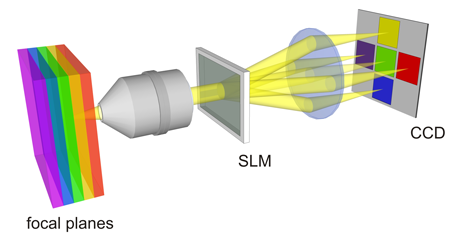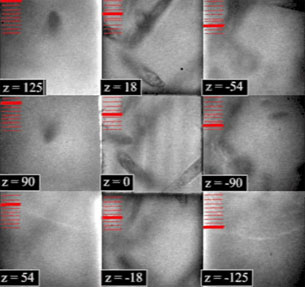SLM-aided multiplexing:
A major advantage provided by high-resolution SLMs (Spatial Light Modulators) is the possibility to flexibly multiplex images, e.g. to combine images from different depths of the sample or for different settings of imaging parameters in one recorded image, facilitating e.g. quantitative phase microscopy.
Depth-of-field-multiplexing (DoFM)
choosing a phase mask on the SLM that corresponds to a set of superposed gratings and multi-focal off-axis Fresnel lenses, which sharply image different focal planes of the object to non-overlapping adjacent sections of a high-resolution camera chip, provides simultaneous imaging of z-stacks in thick transparent samples. DoFM allows one to record motion in a three dimensional sample volume in real-time. The thickness of the slices depends on the effective NA of the microscope (typically a few μm) and the depth that can be reached on the light attenuation in the sample (up to 70-80 μm).
 |
 Movie (4MB) |
Publication(s):
C. Maurer, S. Khan, S. Fassl, S. Bernet, and M. Ritsch-Marte: Depth-of-field-multiplexing in microscopy, Opt. Express 18, 3023-3034 (2010).
Multiplexing in parameter space: quantitative DIC
Fourier filtering methods require some degree of spatial coherence in the illumination. Shearing microscopy methods, such as differential interference contrast (DIC), however, split the light into two slightly displaced beams through the sample and make phase gradients visible by recombining and interfering them, and are thus suitable for spatially incoherent light.
These methods can also be implemented using the SLM as a programmable diffractive element in the optical path – with the advantage that the orientation and magnitude of the shear angle and the relative phase of the two interfering beams can all be varied at video rates.
Moreover, it is possible to multiplex the shearing parameters and map them to non-overlapping regions of the camera chip in order to record a complete set of phase shifted DIC images that is necessary for quantitative phase retrieval in one single camera exposure. This facilitates quantitative snap-shot imaging of a sample and enables the investigation of fast dynamic processes.
 |
 |
Publication(s):
T. C. McIntyre, C. Maurer, S. Bernet, and M. Ritsch-Marte: Differential interference contrast imaging using a spatial light modulator, Optics Letters 34, 2988 (2009).
T.C. McIntyre, C. Maurer, S. Fassl, S. Khan, S. Bernet, and M. Ritsch-Marte: Quantitative SLM-based differential interference contrast Imaging, Optics Express 18, 14063-14078 (2010).



